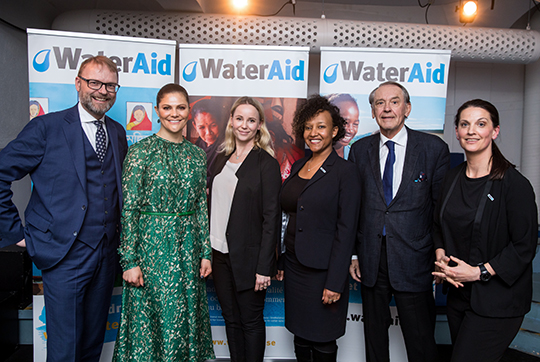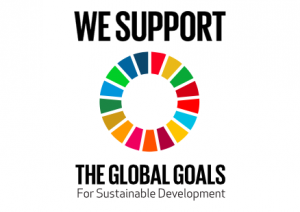Princesa Victoria da Suécia apoia Dia Mundial da Água / Crown Princess Victoria of Sweden supports World Water Day
Na passada quinta-feira assinalou-se o Dia Mundial da Água. O acesso a sistemas sanitários e a água de qualidade para todos é um dos Objectivos Globais das Nações Unidas para um Desenvolvimento Sustentável (SDG). A Princesa da Coroa Victoria da Suécia, é uma das grandes embaixadoras dos SDG's com especial foco na qualidade da água. Foi nesse sentido que a futura Rainha da Suécia participou na semana passada na palestra " Conversas sobre a Água" organizada pela WaterAid, em Estocolmo. Victoria é Patrona da WaterAid desde 2011.
Last Thursday World Water Day was marked. Access to quality sanitation and clean water for all is one of the United Nations Global Goals for Sustainable Development (SDG). Crown Princess Victoria of Sweden is one of the great ambassadors of SDG's with a special focus on water quality. Because of that the future Queen of Sweden participated last week in WaterAid's "Conversations on Water" lecture in Stockholm. Victoria has been a Patron of WaterAid since 2011.
Last Thursday World Water Day was marked. Access to quality sanitation and clean water for all is one of the United Nations Global Goals for Sustainable Development (SDG). Crown Princess Victoria of Sweden is one of the great ambassadors of SDG's with a special focus on water quality. Because of that the future Queen of Sweden participated last week in WaterAid's "Conversations on Water" lecture in Stockholm. Victoria has been a Patron of WaterAid since 2011.
Esta palestra, que contou com vários investigadores que trabalham no melhoramento das condições de acesso à água por todo o mundo, membros da WaterAid e voluntários, focou-se na partilha de diferentes perspectivas sobre a forma como o acesso a água limpa é essencial para combater a pobreza, reforçar os direitos das mulheres e dar às crianças a oportunidade de ir à escola.
This event, which featured a number of researchers working to improve water access conditions around the world, WaterAid members and volunteers, focused on sharing different perspectives on how access to clean water is essential to combat poverty, strengthen the rights of women and give children the opportunity to go to school.
This event, which featured a number of researchers working to improve water access conditions around the world, WaterAid members and volunteers, focused on sharing different perspectives on how access to clean water is essential to combat poverty, strengthen the rights of women and give children the opportunity to go to school.
 |
| Photo: Magnus Frödeberg/WaterAid via Kungahuset.se |
Conceitos que podem parecer muito distintos mas que estão mais ligados do que parece à primeira vista. Os dados são assustadores e provocam um nó na garganta para alguém, como eu, que está a escrever este post no conforto da sua cozinha, onde existe água canalizada e inclusive um sistema de filtragem de água doméstico. Ora vejamos alguns dados disponíveis no site da WaterAid:
Concepts that may seem very distinct but are more connected than it seems at first glance. The data are scary and cause a lump in the throat for someone like me writing this post in the comfort of their kitchen, where there is piped water and even a domestic water filtration system. Let's look at some data available on WaterAid website:
Concepts that may seem very distinct but are more connected than it seems at first glance. The data are scary and cause a lump in the throat for someone like me writing this post in the comfort of their kitchen, where there is piped water and even a domestic water filtration system. Let's look at some data available on WaterAid website:
Quase 290.000 crianças menores de cinco anos morrem todos os anos de diarréia causada por água suja e falta de saneamento. São cerca de 800 crianças por dia, 33 crianças por hora, uma criança a cada dois minutos.
Almost 290,000 children under the age of five die every year from diarrhea caused by dirty water and lack of sanitation. There are about 800 children a day, 33 children per hour, one child every two minutes.( WASHwatch.org 2017)
85% da África subsariana não tem a opção de lavar as mãos com sabão e água.
85% of sub-Saharan Africa does not have the option to wash their hands with soap and water.( WHO / UNICEF Joint Monitoring Program (JMP) Progress in drinking water, sanitation and hygiene - 2017)
Mulheres e meninas são responsáveis por irem buscar água em 8 de 10 domicílios sem água em casa.
Women and girls are responsible for fetching water in 8 out of 10 households without water at home. ( WHO / UNICEF Joint Monitoring Program (JMP) Progress in drinking water, sanitation and hygiene - 2017 update)
159 milhões de pessoas ainda são forçadas a retirar água de locais onde a água não foi tratada. 58% dessas pessoas vivem na África Subsariana.
159 million people are still forced to withdraw water from places where water has not been treated. 58% of these people live in sub-Saharan Africa.( WHO / UNICEF Joint Monitoring Program (JMP) Progress in drinking water, sanitation and hygiene -2017 update)
Até 2015, 2.682.000 crianças no mundo morreram durante os primeiros 28 dias de vida (mortalidade neonatal), o que significa 36 de 1.000 bebés. 99% dessas mortes ocorreram nos países de baixo ou médio desenvolvimento. Um quinto dessas crianças poderia ter sido salvo se tivesse tido acesso a banhos com água limpa e tivesse sido cuidada por pessoas que levem as mãos regularmente.
By 2015, 2,682,000 children worldwide died during the first 28 days of life (neonatal mortality), which means 36 of 1,000 babies. 99% of these deaths occurred in low- or middle-income countries. One-fifth of these children could have been saved if they had had access to clean water baths and had been looked after by people who regularly wash their hands.(United Nations Population Division, 2015).
Quase 900 milhões de pessoas (892 milhões) em todo o mundo fazem as suas necessidades ao ar livre.
Nearly 900 million people (892 million) worldwide go to the "toilette" on open air.( WHO / UNICEF Joint Monitoring Program (JMP) Progress in drinking water, sanitation and hygiene -2017 update)
A WaterAid divulgou em conexão com o Dia Mundial da Água o seu relatório anual sobre o estado da água no Mundo. Além dos dados que referi acima, o relatório mostra que 844 milhões de pessoas actualmente não têm acesso à água potável e que 60% da população mundial vive em áreas onde existe escassez de água. O relatório também mostra que países são os mais afectados pela crise global da água. Com 163 milhões de pessoas sem acesso a água limpa, a Índia é o país do mundo onde a maioria das pessoas não tem água potável. Com base na proporção da população, a crise da água é pior nos países africanos, nomeadamente na África Subsariana.
A WaterAid é uma organização internacional independente que trabalha para transformar vidas melhorando o acesso à água limpa, saneamento e higiene nas comunidades mais pobres do mundo. Colaboram com parceiros locais para soluções sustentáveis e de longo prazo e influenciam os tomadores de decisão em nível global e nacional para aumentar as prioridades e os esforços para essas necessidades básicas.
WaterAid released in connection with World Water Day its annual report on the state of water in the world. In addition to the data I mentioned above, the report shows that 844 million people currently do not have access to safe water and that 60% of the world's population lives in areas where there is water shortage. The report also shows which countries are hardest hit by the global water crisis. With 163 million people without access to clean water, India is the country in the world where most people lack clean water. Based on the proportion of the population, the water crisis is the worst in African countries, especially in sub-Saharan Africa.
WaterAid is an independent international organization that works to transform lives by improving access to clean water, sanitation and hygiene in the world's poorest communities. They collaborate with local partners for sustainable and long-term solutions and influence decision-makers at the global and national levels to increase priorities and efforts for these basic needs.
Quem me lê, sabe que este blog também serve para isto. Não é bonito, não é glamouroso, mas é a realidade. Uma realidade à qual não podemos virar costas.
Por isso mesmo, a partir de hoje, vou adicionar o selo dos SDG's a este blog. O T&T passa a ser assim Embaixador não-oficial dos Objectivos Globais das Nações Unidas para um Desenvolvimento Sustentável. E convido-vos a todos que assumam este compromisso comigo!
Who reads me, knows that this blog also serves for this. It's not beautiful, it's not glamorous, but it's reality. A reality that we can not turn our backs on.
That's why, starting today, I'm going to add the SDG's stamp to this blog. T & T thus becomes the unofficial Ambassador of the United Nations Global Goals for Sustainable Development. And I invite you all to take up this commitment with me!
[Kungahuset.se]
Who reads me, knows that this blog also serves for this. It's not beautiful, it's not glamorous, but it's reality. A reality that we can not turn our backs on.
That's why, starting today, I'm going to add the SDG's stamp to this blog. T & T thus becomes the unofficial Ambassador of the United Nations Global Goals for Sustainable Development. And I invite you all to take up this commitment with me!
[Kungahuset.se]


Comentários
Enviar um comentário